This article needs additional citations for verification .(February 2010) |
This article may be expanded with text translated from the corresponding article in German. (March 2009)Click [show] for important translation instructions.
|
This article needs additional citations for verification .(February 2010) |
This article may be expanded with text translated from the corresponding article in German. (March 2009)Click [show] for important translation instructions.
|

Mein Kampf is a 1925 autobiographical manifesto by Nazi Party leader Adolf Hitler. The work describes the process by which Hitler became antisemitic and outlines his political ideology and future plans for Germany. Volume 1 of Mein Kampf was published in 1925 and Volume 2 in 1926. The book was edited first by Emil Maurice, then by Hitler's deputy Rudolf Hess.

The Beer Hall Putsch, also known as the Munich Putsch, was a failed coup d'état by Nazi Party leader Adolf Hitler, Generalquartiermeister Erich Ludendorff and other Kampfbund leaders in Munich, Bavaria, on 8–9 November 1923, during the Weimar Republic. Approximately two thousand Nazis marched on the Feldherrnhalle, in the city centre, but were confronted by a police cordon, which resulted in the deaths of 16 Nazi Party members and four police officers.

Max Brod was a Czech German-speaking Jewish, later Israeli, author, composer, and journalist. Although he was a prolific writer in his own right, he is best remembered as the friend and biographer of writer Franz Kafka. Kafka named Brod as his literary executor, instructing Brod to burn his unpublished work upon his death. Brod refused and had Kafka's works published instead.
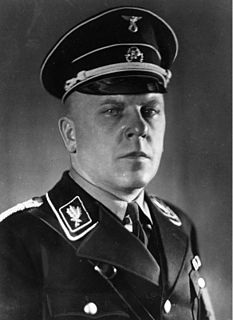
Max Amann was a high-ranking member of the Nazi Party, a German politician, businessman and art collector, including of looted art. He was the first business manager of the Nazi Party and later became the head of Eher Verlag, the official Nazi Party publishing house. He was also the Reichsleiter for the press. After the war ended, Amann was arrested by Allied troops. Amann was deemed a Hauptschuldiger and sentenced to ten years in a labour camp. He was released in 1953. Amann died in poverty in Munich.
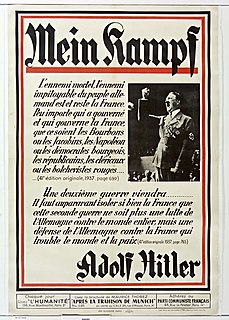
The political views of Adolf Hitler have presented historians and biographers with some difficulty. His writings and methods were often adapted to need and circumstance, although there were some steady themes, including antisemitism, anti-communism, anti-parliamentarianism, German Lebensraum, belief in the superiority of an "Aryan race" and an extreme form of German nationalism. Hitler personally claimed he was fighting against "Jewish Marxism".
Erwin Baur was a German geneticist and botanist. Baur worked primarily on plant genetics. He was director of the Kaiser Wilhelm Institute for Breeding Research. Baur is considered to be the father of plant virology. He discovered the inheritance of plastids.
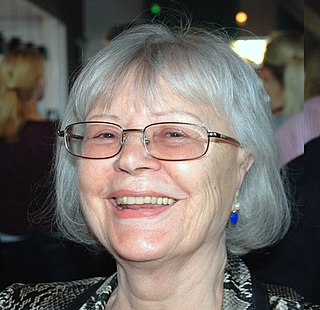
Harriet Andersson is a Swedish actress, best known outside Sweden for being part of director Ingmar Bergman's stock company. She often plays impulsive, working class characters.

The Zweites Buch, published in English as Hitler's Secret Book and later as Hitler's Second Book, is an unedited transcript of Adolf Hitler's thoughts on foreign policy written in 1928; it was written after Mein Kampf and was not published in his lifetime.
Franz Eher Nachfolger GmbH was the central publishing house of the Nazi Party and one of the largest book and periodical firms during the Third Reich. It was acquired by the party on 17 December 1920 for 115,000 Papiermark.
Kampf or Kaempf may refer to:
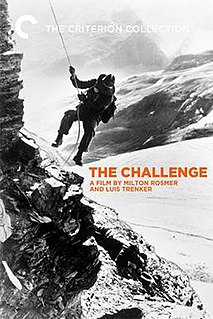
The Challenge is a 1938 British drama film directed by Milton Rosmer and Luis Trenker and starring Robert Douglas and Luis Trenker. The film is about the first successful ascent of the Matterhorn in 1865 by Edward Whymper.

Mein Kampf, Adolf Hitler's 900-page autobiography outlining his political views, has been translated into Arabic a number of times since the early 1930s.
I Am a Thief is a 1934 American crime-drama film directed by Robert Florey.

Arthur Kampf was a German painter. He was associated with the Düsseldorf school of painting.
Max Mack (1884–1973) was a German screenwriter, film producer and director during the silent era. He is particularly known for his 1913 film The Other. He directed, and co-starred in, an early film adaptation of Dr. Jekyll and Mr. Hyde in 1914, called Ein Seltsamer Fall, written by Richard Oswald. During the 1910s, he directed nearly a hundred films in a variety of different genres.

Fight of the Tertia is a 1929 German silent family film directed by Max Mack and starring Max Schreck, Fritz Richard and Fritz Greiner. It is based on the 1928 novel of the same name by Wilhelm Speyer which was later adapted into a 1952 sound film. Youth gangs clash in a small town on the Baltic Sea. The film's art direction was by Hans Jacoby.
The Trial of Donald Westhof is a 1927 German silent crime film directed by Fritz Wendhausen and starring Oskar Homolka, Karin Evans and Imre Ráday. The film's sets were designed by the art director Robert Neppach.
Arminius is an oratorio by the German composer Max Bruch. Bruch wrote the work between 1875 and 1877 during the consolidation of the newly founded German Empire. He picked the story revolving around Arminius and the Cherusci-led defeat of three Roman legions in the Teutoburg Forest in 9 A.D., which served as a German national myth from the 16th to the early 20th century.
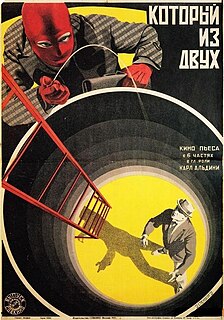
The Battle Against Berlin is a 1926 German silent film directed by Max Reichmann and starring Carlo Aldini, Jenny Jugo and Raimondo Van Riel.
Ever since the early 1930s, the history of Adolf Hitler's Mein Kampf in English has been complicated and has been the occasion for controversy. No fewer than four full translations were completed before 1945, as well as a number of extracts in newspapers, pamphlets, government documents and unpublished typescripts. Not all of these had official approval from his publishers, Eher Verlag. Since the war, the 1943 Ralph Manheim translation has been the most popular published translation, though Manheim later expressed reservations about his translation, and other versions have continued to circulate.